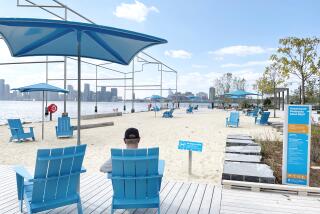Hurricane Sandy leaves a sea of heartache in Staten Island
OAKWOOD BEACH, N.Y. — They were found hugging, a former Marine and his blue-eyed son, buried under the wreckage of the home they had hoped to save.
John “Flip” Filipowicz and 20-year-old John Jr. had defied orders to evacuate as Hurricane Sandy approached Monday, determined to pump water out of their basement. But the massive tidal surge and raging floodwaters crushed the foundation, and a wall of concrete collapsed on them.
Police discovered the pair the next day, their arms wrapped around each other. They lay amid the wreckage of this working-class neighborhood of firemen and cops, postal workers and corrections officers, on the southern lip of Staten Island, the always-forgotten New York City borough that suffered the worst in Sandy’s terrible maw.
“They were hugging, and it breaks my heart to think that Flip was telling John, ‘I can’t save you,’ ” said their neighbor Sue Somma.
Much of New York is staggering to its feet after the storm, like a giant shaking off an unexpected pummeling. Although hundreds of thousands of people remain without power or working phones, and public transit is still a nightmare, services are slowly coming back in Manhattan, and offices and shops are tentatively reopening their doors. Mayor Michael R. Bloomberg even announced that the annual New York City marathon, the world’s largest, will take place as scheduled Sunday.
But the hardest-hit communities, like this one, are struggling with desperate heartache and irreplaceable loss.
At least 19 of the city’s 40 storm-related fatalities were in Staten Island’s evacuation zones, close-knit communities like Oakwood Beach, Midland Beach, South Beach and Tottenville, the same towns that lost so many first responders who rushed to the rescue during the Sept. 11, 2001, terrorist attack on the World Trade Center across the harbor.
The dead included an 80-year-old woman, Beatrice Spagnuolo, and 13-year-old Angela Dresch, an eighth-grader who was washed out of her home by a monster wave, her body found a block away. Also killed was Artur Kasprzak, an off-duty New York police officer, who guided seven members of his family to safety in the attic as the waters rose.
“Officer Kasprzak then turned to one of the women and told her he was going to check the basement but would be right back,” the NYPD said in a statement. He never returned, and his body was found the next day. Police believe he was electrocuted when live wires touched the floodwaters.
On Thursday, police recovered the bodies of two more local victims, Connor and Brendan Moore, aged 4 and 2. Their mother, Glenda, told police she had tried to escape the storm in her Ford Explorer after losing power at home, but it stalled in a maelstrom, and the two toddlers were ripped from her arms as she tried to escape on foot. She is a nurse, her husband a sanitation worker.
With more than a dozen others still reported missing, police helicopters rattled overhead Thursday searching for bodies and survivors, as rescuers combed through mounds of rubble.
Most of the victims had ignored orders to leave because they couldn’t fathom Sandy’s size and power, city officials said. Hurricane Irene didn’t live up to its ferocious billing last summer, so some apparently tried to ride out Sandy’s brutal 90-mph winds by sheltering in their basements.
They were trapped as floodwaters raced in, first knee-deep, then waist-deep, then 10 feet deep in some places. Giant waves knocked homes off their foundations, and sent cars and rooftops floating away.
“No one believed it would be as devastating as it was,” said Staten Island Dist. Atty. Dan Donovan, who visited the area Thursday.
On Fox Beach Avenue, a bouquet of flowers lay outside the flood-ravaged home of Leonard Montalto, 53. He drowned in his basement after he went to check his water pump.
Neighbors who searched for Montalto the next day broke the basement windows and peered inside. All they could see was inky water and debris. Rescue divers swam in on Wednesday and found the body.
Neighbors said Montalto, a genial U.S. Postal Service worker who delivered the local paper and collected Beanie Babies, had lived in the single-story home since he was a boy. One of his three daughters, Nicole, was with him as the storm approached, but he ordered her to leave in his car shortly after 7 p.m., when the water began to rise.
Later that night, Montalto called his daughter to say it was good she got out. It was the last anyone heard from him.
A neighbor, Sebastian Stankiewicz, said he drove by about 7 p.m. and saw just a few inches of water on the street. By the time he had turned his car around and returned home, about 500 yards away, the water was knee-deep and rising fast. He and his wife were barely able to drive away.
“It was so fast,” said Stankiewicz, who stood in his waterlogged backyard. Sodden clothes hung from a line near muddy toys on the ground.
The sorrow was leavened by tales of survival. A few doors down, Frank Langello rushed up to his attic as the water rose. He carried a cat and four dogs, including a 110-pound Weimaraner. Langello had an inflatable raft but realized it wouldn’t survive the rushing water, especially with nervous animals. So he sat for hours with Doritos and bottles of water and waited.
Finally, well after midnight, a neighbor paddled over in a metal fishing boat that he had found floating nearby. Leaving the cat, Langello jumped in with the dogs. Neighbors who’d been trapped in other homes climbed in as well, and they rowed themselves to higher ground in the rain and wind. Langello returned the next day to find the cat unscathed.
Filipowicz, a 51-year-old former corrections officer, had sent his wife, daughter and another son — John Jr.’s twin — to take refuge with relatives. Somma, the neighbor, described the former Marine as “a survivor” who probably planned to drink a few beers with John Jr., who worked at Burger King, while the hurricane raged outside.
The next day, Somma said, she and her husband saw a 20-foot-wide hole where the concrete foundation had caved into the basement.
Friends had placed flowers on the front steps, along with pictures of a smiling John Jr. with a long arm around his sturdily built father. One friend had signed a message: “R.I.P. Flip. Only the good die young.”
More to Read
Start your day right
Sign up for Essential California for news, features and recommendations from the L.A. Times and beyond in your inbox six days a week.
You may occasionally receive promotional content from the Los Angeles Times.







